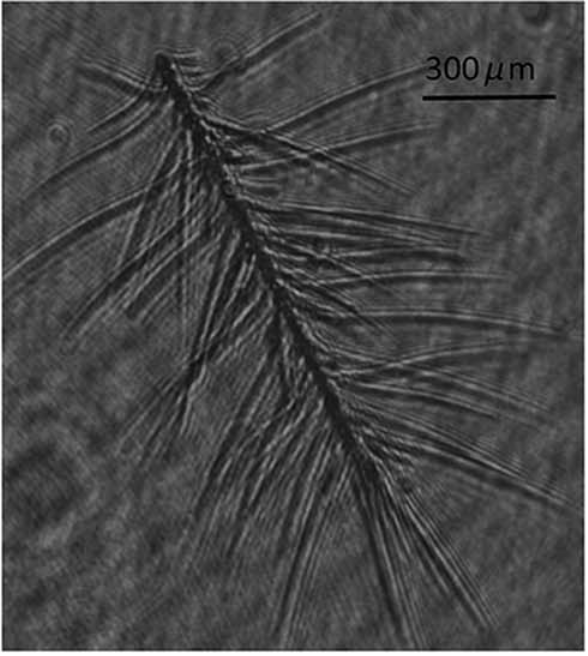Nayak, A. R., McFarland, M. N., Sullivan, J. M. and Twardowski, M. S. (2017), Evidence for ubiquitous preferential particle orientation in representative oceanic shear flows. Limnol. Oceanogr.. doi:10.1002/lno.10618

The ocean is teeming with diverse, tiny particles — a catchall term for the living organisms, organic detritus, and many types of inorganic material that populate the microscale. This particulate matter plays an important role in far flung corners of oceanography, from sediment transport to climate science. Sometimes, like in ecological studies, certain kinds of organic particles are the main attraction. In other cases, such as any project making use of satellite data, researchers are primarily concerned with how the particles are influencing light in the water.
Despite the ubiquity of particles in ocean sciences, the details of how moving water effects their distribution is poorly understood. In fact, most scientists assume that particles in the ocean are randomly distributed; no matter what is happening in the water, all the microscopic matter is pointing any which way. The issue is not as esoteric as it may sound: consider that model simulations have demonstrated that if particles in water are all forced into the same orientation, meaning the long axis of the objects are aligned, then the water reflects up to 30% more light. Such a change would substantial increase how much light makes it to satellite sensors.
Dr. Aditya Nayak, of the Harbor Branch Oceanographic Institute, was not convinced that particles are always uniformly oriented. In his recent paper, Dr. Nayak pointed to a number of theoretical treatments that indicate that particles in moving water can be forced into a particular orientation by shear stress, the fluid mechanical term describing the force between two fluids move relative to one another. Water in the ocean is constantly in motion, so how could small particles remain randomly oriented?

Several laboratory studies have demonstrated that particulate matter does orient in one direction when forced by typical amounts of oceanic shear. But no systematic study of particle orientation has been undertaken in the ocean itself. Dr. Nayak and his collaborators decided to attempt just such an experiment.
To collect the necessary data, Dr. Nayak and his team had to develop a custom instrument package. The system they put together contained a suite of optical and acoustic instruments to capture lots of information about the particle field at the same time. The two key pieces of equipment were the acoustic Doppler velocimeter (ADV), to measure current speed, and a special imaging system, called the HOLOCAM, to take pictures of the particles (Fig. 1). Both devices were placed at the very bottom of a 1.5-meter, square metal frame.
The researchers took their system to a fjord near the San Juan Islands in Washington State and collected data at fifty stations. At each station, the system was put in the water and slowly lowered by a winch. To avoid disturbing the particles with the instrument itself, only measurements from the downcast were saved.
After the field deployment, Dr. Nayak selected four profiles to analyze. A particular kind of colonial diatom, Ditylum brighwellii, dominated the particle assemblage in all four. D. brighwellii can form rather large chains, making them ideal indicators of preferential orientation (Fig. 2). Dr. Nayak counted all the chains and analyzed where they were pointing by measuring the angle between the long axis of the chain and horizontal. He then compared the average chain angle to current information from the ADV.

Dr. Nayak found that these chains were uniformly oriented in certain zones of all the profiles. When the shear was low or near zero, the D. brighwellii all pointed in the direction of the fluid motion. When the water was faster or more turbulent, the chains were oriented every which way. The implication is that particles — particular long, skinny ones — are subject to forcing by water and are not uniformly random throughout the whole ocean.
This study was the result of preliminary analysis of a much larger dataset. Should Dr. Nayak and his team’s results prove to be consistent, they could have far reaching impacts. Subjects from phytoplankton ecology to acoustics to ocean optics may have to be retooled and refined. Sometimes it’s the tiniest details that can have the largest impact.
Eric is a PhD student at the Scripps Institution of Oceanography. His research in the Jaffe Laboratory for Underwater Imaging focuses on developing methods to quantitatively label image data coming from the Scripps Plankton Camera System. When not science-ing, Eric can be found surfing, canoeing, or trying to learn how to cook.


